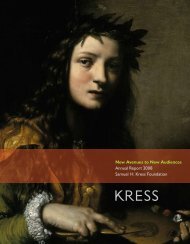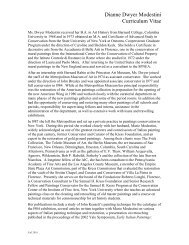The Campus Art Museum - Samuel H. Kress Foundation
The Campus Art Museum - Samuel H. Kress Foundation
The Campus Art Museum - Samuel H. Kress Foundation
Create successful ePaper yourself
Turn your PDF publications into a flip-book with our unique Google optimized e-Paper software.
cognizant of what is going on globally and he makes me feel like I am in<br />
the loop. He is a member of all these organizations and yet knows how to<br />
nurture our enthusiasm by not squashing our ideas. He shows an openness to<br />
everything. He is also adept at relating with people above him in the university<br />
hierarchy. He’s respected.<br />
Fund Raising. Many directors of campus art museums have to go further<br />
afield than the campus and its community to court donors and raise funds for the<br />
museum. This is not necessarily a role for which directors were trained, nor one<br />
all particularly enjoy. Nonetheless, exemplary campus art museums tend to have a<br />
director who is good at raising funds:<br />
<strong>The</strong> part that I was most worried about and, in a way, find the most satisfying<br />
is trying to raise money for the institution. We created a national advisory<br />
board.… We meet once a year…, they come at their own expense, and when<br />
they join the board, I tell them, the expectation is that we get some committed<br />
annual support and… when they are ready for it, a major gift—we’re really<br />
talking hundreds of thousands and into the millions…. When I started out, we<br />
had absolutely zero in endowments and I think we have thirteen million in<br />
place now. (museum director)<br />
<strong>The</strong> exemplary campus art museum tends to have a national advisory board or<br />
council. <strong>The</strong>se boards are made up of “people from other museums, collectors, and<br />
benefactors.” In general, members of these boards are expected not only to help<br />
with strategic planning and facilitate connections to potential donors, but also to<br />
contribute financially themselves.<br />
In addition to seeking donors, the successful museum leader is active in<br />
applying for grants as described by an administrator working with grants and<br />
outside funding, “I think we have put in more grants probably in [the museum<br />
director’s] first year than we had the three years before. She started in July and I<br />
think we did our first grant in October.” As this administrator went on to say, the<br />
director did “a really good job of engaging curatorial and other staff” in the grantwriting<br />
process, so that there was “buy-in on their part” and also so that the grants<br />
were informed by the specialized knowledge that the staff could bring to it.<br />
Maintaining a Connection to <strong>Art</strong>. <strong>Museum</strong> directors’ lives can get so hectic<br />
that connection to art, what often brought them to the director’s position in the<br />
first place, can get set aside. Directors speak of art as both a creative and spiritual<br />
base for their lives. As one director stated: “When I have a bad day…, it’s always the<br />
art that gets me through.” This director begins each staff meeting with time in the<br />
galleries. She also works to bring in visiting artists so that they can help replenish<br />
the creative well for students, faculty, the public, and herself.<br />
<strong>The</strong> museums in this study were chosen because they are exemplary in some<br />
way. This exemplarity is reflected in the leadership of the museums. <strong>The</strong> directors,<br />
however, must have a good team with which to work. <strong>The</strong>y do. <strong>The</strong> talent, energy,<br />
and thoughtfulness of the museum personnel with whom I met are extraordinary.<br />
It’s Not History and Culture Alone: People Make the <strong>Museum</strong><br />
17
















